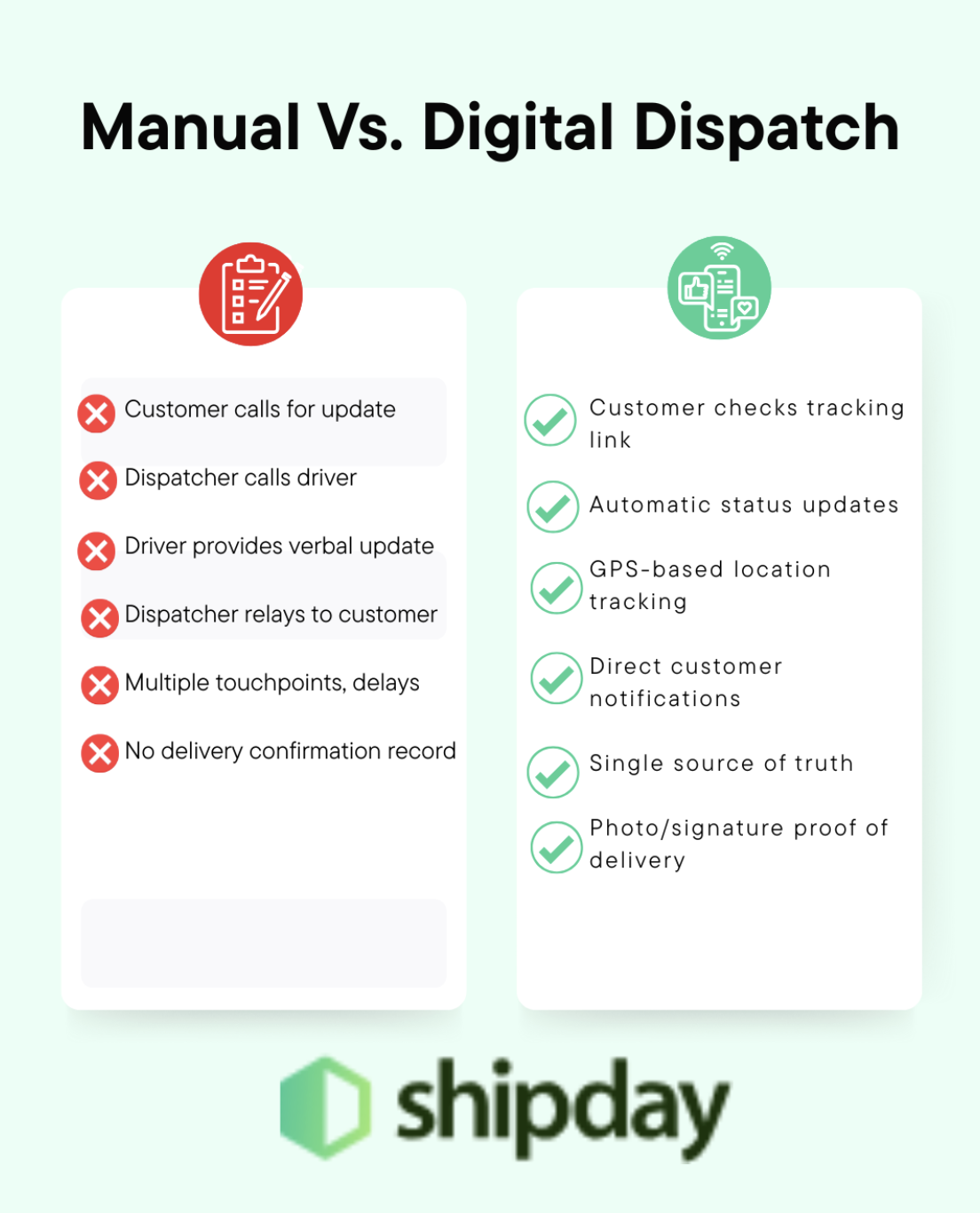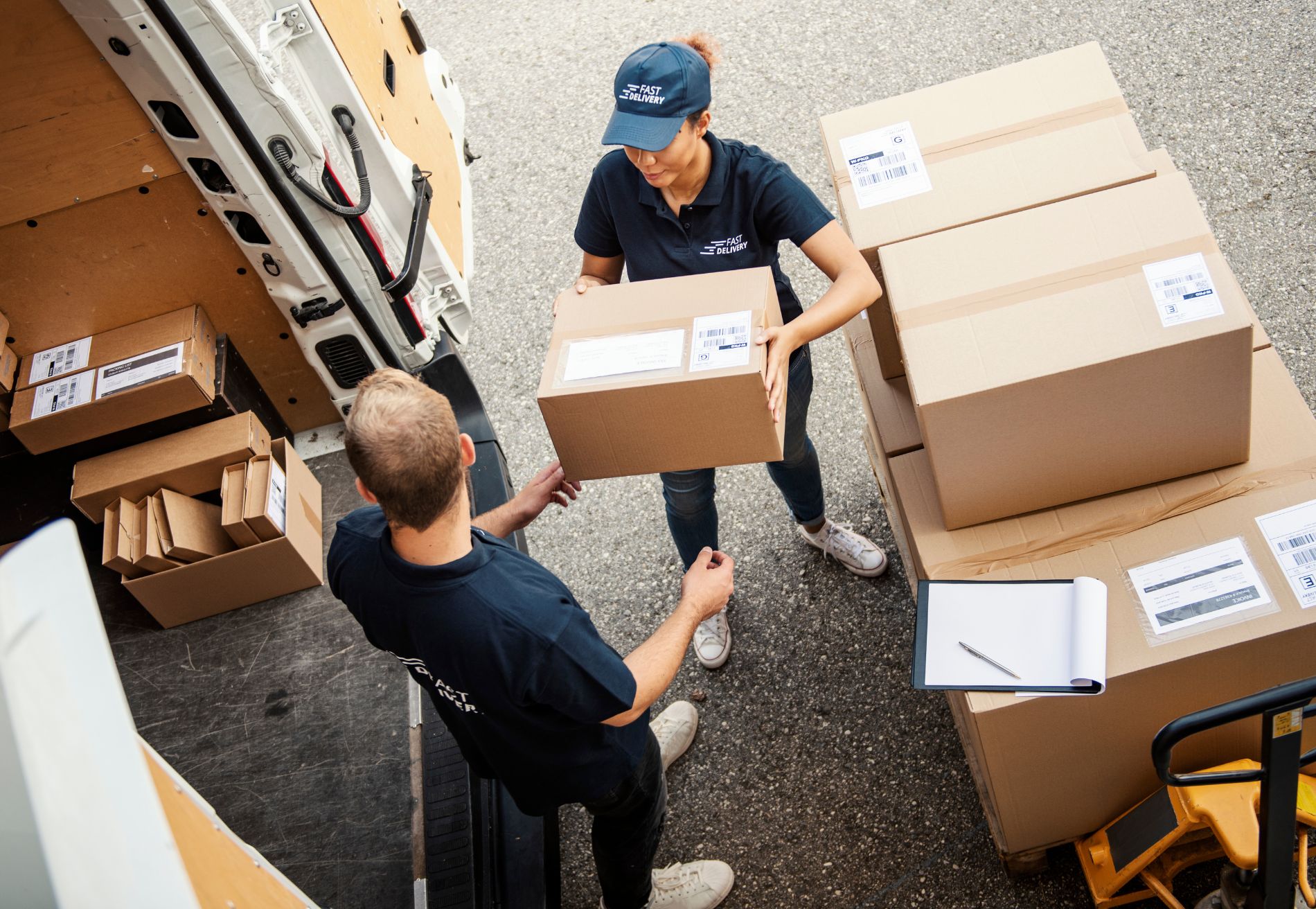How Courier Companies Enhance Reliability and Transparency Using a Delivery Management App

Customer expectations for same-day delivery and live tracking are forcing courier companies to overhaul outdated systems. Manual spreadsheets and two-way radios slow down dispatch decisions and delay customer updates. This guide examines how delivery management applications cut dispatch time and help managers fix delays faster.
Key Takeaways:
- Real-time tracking systems reduce customer inquiries and improve satisfaction.
- Automated dispatch and route optimization increase delivery capacity without adding vehicles or drivers, maximizing the efficiency of existing resources
- Digital proof of delivery and documentation streamline operations by eliminating paper-based processes.
- Performance analytics enable continuous improvement by identifying bottlenecks, tracking driver productivity, and measuring key operational metrics
- Integration capabilities connect delivery operations with existing business systems, creating seamless workflows from order placement through final delivery
Real-Time Tracking Eliminates Information Gaps
Without live tracking, dispatchers can’t respond quickly, and customer service teams are flooded with status calls. Customer service teams struggle to provide accurate delivery updates and constantly ping your dispatcher. Management lacks the data to identify and resolve delivery issues promptly.
Delivery management applications address these challenges by providing continuous location updates and automated status notifications throughout the delivery journey. When drivers update their status through mobile applications, the information instantly becomes available to dispatchers, customer service teams, and end customers through various channels.

With automated updates, companies saw 90% fewer ‘Where’s my order?’ calls. Businesses using delivery management platforms report a 90% reduction in customer inquiry calls about delivery status, as customers can independently track their orders through real-time GPS updates. Dispatchers can reroute drivers in real time to avoid delays.
When customers can independently check delivery status, their satisfaction increases, even when deliveries experience minor delays. This transparency builds trust and can even reduce the perceived wait time through regular progress updates.
{"type": "ad-card", "title": "Start with Shipday and grow your business", "description": "Shipday Delivery Management includes analytics in even the free, baseline subscription. But it’s also built to scale with enterprise-level courier brands. See what your delivery business looks like with advanced reporting tools.", "primary-button": {"text": "Get started free", "link": "https://dispatch.shipday.com/signUp?_gl=1*f4c9ho*_gcl_au*MTgyNjg4MjQuMTc1NDY0NTE1NQ..*_ga*NTkyMzI5NjA5LjE3NTQ2NDUxNTM.*_ga_FZPT7TD7CG*czE3NTQ2Nzk4MDckbzQkZzEkdDE3NTQ2ODAyODgkajUwJGwwJGgw"}, "secondary-button": {"text": "Book a demo", "link": "https://shipday.com/sales?_gl=1*f4c9ho*_gcl_au*MTgyNjg4MjQuMTc1NDY0NTE1NQ..*_ga*NTkyMzI5NjA5LjE3NTQ2NDUxNTM.*_ga_FZPT7TD7CG*czE3NTQ2Nzk4MDckbzQkZzEkdDE3NTQ2ODAyODgkajUwJGwwJGgw"}}
Automated Dispatch and Route Optimization Maximize Efficiency
Manual dispatch processes limit courier companies to basic zone-based or first-come, first-served delivery assignments. Dispatchers spend hours organizing routes, often relying on driver knowledge and experience rather than data-driven optimization.
Modern delivery management applications, on the other hand, use algorithmic route optimization that accounts for variables like vehicle type and driver skill.
The automation extends beyond initial route planning. Dynamic rerouting capabilities allow delivery management software systems to adjust for unexpected circumstances such as traffic incidents or vehicle breakdowns. This adaptability ensures courier companies maintain service levels despite daily operational challenges.
Real-world implementations demonstrate significant efficiency gains from route optimization. Pizza Guys improved their on-time delivery rates from 90-92% to over 98% within just a few weeks of implementing automated dispatch.² General Tso's doubled driver productivity and achieved a 20% improvement in delivery times.³ These improvements translate directly to increased delivery capacity without adding vehicles or drivers.
That doesn’t mean you should fire your dispatcher. With delivery management software, you’ll enable your dispatch team to focus on complex scenarios and continuous process improvement rather than repetitive daily planning tasks.
Digital Documentation Reduces Disputes and Accelerates Payment
Chasing down missing delivery slips wastes hours and delays payments. Drivers manage stacks of delivery sheets, and office staff manually enter confirmation data. Disputed deliveries require extensive research through physical records. Lost or damaged paperwork can result in payment delays and customer disputes.
Drivers snap photos and collect e-signatures on the spot, cutting errors and settling disputes faster.
The accuracy improvement is substantial. General Tso's achieved a 75% reduction in delivery errors after implementing digital proof of delivery, while also saving 3 to 4 staff hours per week in manual coordination tasks.
Beyond basic delivery confirmation, digital systems capture a comprehensive delivery context. GPS coordinates verify delivery location, timestamps provide precise delivery times, and photos document package condition and placement. This rich data set protects courier companies from fraudulent claims while accelerating invoice processing and payment collection.
The immediate availability of delivery confirmations can also enable faster billing cycles. Instead of waiting for drivers to return paperwork at the end of their shifts, billing departments can begin processing invoices the moment deliveries are complete. For courier companies operating on tight margins, this acceleration in cash flow can be the difference between making a week’s payroll.
Performance Analytics Drive Continuous Improvement
Traditional courier operations rely on basic metrics such as daily delivery counts and on-time percentages. These are often calculated manually from driver logs. This arrangement forces managers to spend most of their day on data management, rather than on data analysis that could help them identify improvement opportunities that build business.
If you’re still tracking deliveries in Excel, you’re missing critical trends—like why late deliveries spike on Fridays. Delivery management applications automatically collect and analyze comprehensive operational data, enabling managers to identify consistently delayed drivers and address route bottlenecks.
The predictive capabilities of advanced analytics prove particularly valuable. By analyzing your historical patterns, delivery management systems can forecast demand spikes and recommend preventive actions before problems occur. Dispatchers will be better able to identify patterns that inform better route planning. Managers gain visibility into trends that guide strategic investments in vehicles, technology, and market expansion.
KFC Barbados achieved over $400,000 in annual savings after implementing delivery management technology across just 6 of their 12 locations, representing up to $1,200 in consolidated daily savings. Similarly, A-Team Delivery experienced 200% growth and ultimately 4x overall business expansion while reducing time spent on manual data management by 60%⁶.
{"type": "ad-card", "title": "Start with Shipday and grow your business", "description": "Shipday Delivery Management includes analytics in even the free, baseline subscription. But it’s also built to scale with enterprise-level courier brands. See what your delivery business looks like with advanced reporting tools.", "primary-button": {"text": "Get started free", "link": "https://dispatch.shipday.com/signUp?_gl=1*f4c9ho*_gcl_au*MTgyNjg4MjQuMTc1NDY0NTE1NQ..*_ga*NTkyMzI5NjA5LjE3NTQ2NDUxNTM.*_ga_FZPT7TD7CG*czE3NTQ2Nzk4MDckbzQkZzEkdDE3NTQ2ODAyODgkajUwJGwwJGgw"}, "secondary-button": {"text": "Book a demo", "link": "https://shipday.com/sales?_gl=1*f4c9ho*_gcl_au*MTgyNjg4MjQuMTc1NDY0NTE1NQ..*_ga*NTkyMzI5NjA5LjE3NTQ2NDUxNTM.*_ga_FZPT7TD7CG*czE3NTQ2Nzk4MDckbzQkZzEkdDE3NTQ2ODAyODgkajUwJGwwJGgw"}}
System Integration Creates Seamless Operations
Isolated delivery management creates information silos that require manual data transfer between systems. Orders from e-commerce platforms must be manually entered into dispatch systems. Delivery confirmations require separate entry into billing software. This duplication of effort increases costs and error rates.
Modern delivery management applications address this challenge by integrating directly with the other software you use to manage your courier business. Imagine how much time you could save each week if your delivery management system communicated with both your payment processor and accounting tools.
These integrations create end-to-end visibility across the entire delivery lifecycle. When an order is placed on an e-commerce platform, it automatically flows into the delivery management system for dispatch planning. As the delivery progresses, status updates flow back to the e-commerce platform and customer. Upon completion, billing information transfers to accounting systems without manual intervention. And with white-labeling options, your brand stays front and center, on every update and every tracking page.
A-Team Delivery compressed their daily logistics management from a full-time job to just 3 to 4 hours through automated workflows, while General Tso's completed their entire system integration in a single day thanks to streamlined API connections. Such rapid implementation means businesses can begin realizing operational benefits almost immediately.
Implementation Considerations and Next Steps
Successfully implementing a delivery management app requires careful planning. You should evaluate platforms based on your:
- Operational needs: Consider what tools and tasks are critical to get right for your drivers, dispatchers, managers, vendors, and end customers.
- Existing technology: Find a system that communicates seamlessly with your current accounting and payment software.
- Growth plans: Work with a delivery management partner that can meet your current and future needs. You don’t want to rebuild on a new platform every time your business grows.
The transition from manual processes to digital systems is a significant operational change that affects every stakeholder, from drivers to customers. Successful implementations typically follow a phased approach, starting with pilot programs to work out the growing pains before expanding system-wide.
If you’re struggling with late deliveries or driver churn, a delivery app gives you tools to fix both.
Learn More
To explore how delivery management technology can transform your courier operations, try a pilot program with Shipday. The delivery management software is free to use for up to 10 drivers. With three additional subscription tiers, Shipday can also scale as your courier business grows. With no long-term contracts, you pay as you grow, and cancel anytime.
Index
Ready to get started?
Play around with it first, add your team, pay later.








.avif)






%201.svg)
